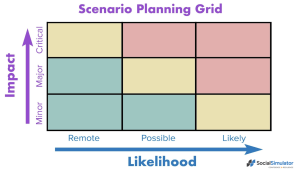In today’s volatile global landscape, businesses face mounting challenges - from economic downturns to geopolitical unrest. Preparing for uncertainty is no longer optional; it’s a strategic necessity for mid and senior-level decision-makers alike.
That’s where scenario planning and risk mapping come into play.
Scenario planning helps businesses to anticipate a range of future possibilities. Building 'what-if' scenarios helps anticipate how factors like inflation, trade restrictions, or political instability could impact operations. This forward-thinking approach enables you to adapt strategies quickly and confidently.
Risk mapping, on the other hand, identifies and prioritizes potential threats to an organization. It can be done in conjunction with scenario planning to provide you with an idea of likely scenarios and priority risks.
By visually assessing both the likelihood and impact of risks - you can gain a clearer understanding of points of vulnerability. This then enables you to prioritize the most serious risks and think through the actions needed to mitigate their impact. Working through this with a cross-functional team is a good way of ensuring that significant risks are mapped methodically across parts of the business.
You can use this matrix to map and prioritise the risks associated with specific scenarios. Risks that are high in likelihood and impact should be prioritized.

Start by thinking through the worst-case scenario and most likely scenario and think through the actions and interventions needed to prevent the likely scenario from escalating into the worst-case scenario.
This provides you with a proactive list of actions you can take to mitigate risks proactively, rather than just waiting for situations to unfold.
Together, scenario planning and risk mapping provide a powerful toolkit for strategic agility. In an era marked by rapid change, companies that prepare for uncertainty are more likely to withstand disruptions and seize emerging opportunities.
Ready to future-proof your business? Start by integrating scenario planning and risk mapping into your strategic processes today.
Please get in touch if you’d like to discuss options for scenario planning and risk mapping with your teams.